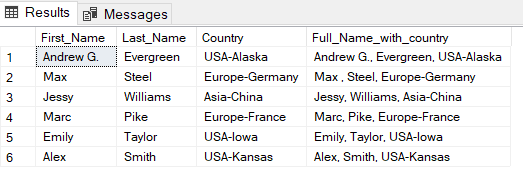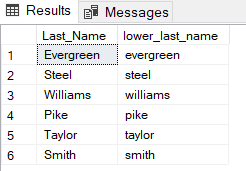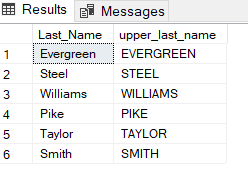- 1 Introduction
- 2 Preparation
- 3 String Functions
- 4 Conclusion
1 Introduction
As announced in my post about Data Manipulation, I’ll return here to the String Functions theme in particular.
SQL Server offers some useful functions that make life much easier when dealing with strings.
2 Preparation
SET LANGUAGE ENGLISH
CREATE DATABASE String_Functions;
USE String_Functions;CREATE TABLE customers
(First_Name VARCHAR(100) NOT NULL,
Last_Name VARCHAR(100) NOT NULL,
Purchasing_Power FLOAT NOT NULL,
Country VARCHAR(100) NOT NULL,
Webpage VARCHAR(100) NOT NULL)
;INSERT INTO customers (First_Name, Last_Name, Purchasing_Power, Country, Webpage) VALUES ('Andrew G.', 'Evergreen', 150.84, 'USA-Alaska', 'us.Alaska.com')
INSERT INTO customers (First_Name, Last_Name, Purchasing_Power, Country, Webpage) VALUES ('Max ', 'Steel', 420.31, 'Europe-Germany', 'eu.Germany.com')
INSERT INTO customers (First_Name, Last_Name, Purchasing_Power, Country, Webpage) VALUES ('Jessy', 'Williams', 85.17, 'Asia-China', 'as.China.com')
INSERT INTO customers (First_Name, Last_Name, Purchasing_Power, Country, Webpage) VALUES ('Marc', 'Pike', 198.22, 'Europe-France', 'eu.France.com')
INSERT INTO customers (First_Name, Last_Name, Purchasing_Power, Country, Webpage) VALUES ('Emily', 'Taylor', 320.78, 'USA-Iowa', 'us.Iowa.com')
INSERT INTO customers (First_Name, Last_Name, Purchasing_Power, Country, Webpage) VALUES ('Alex', 'Smith', 240.45, 'USA-Kansas', 'us.Kansas.com')This is our data set that we will work with:
SELECT *
FROM customers
;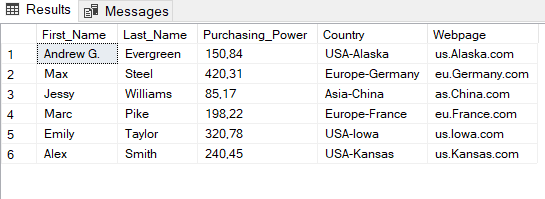
3 String Functions
3.1 Get the length of a character string
For this we can use two functions:
- LEN
- DATALENGTH
Both have their own peculiarities and you should be aware of the difference between them.
SELECT First_Name,
LEN(First_Name) AS len_first_name
FROM customers
;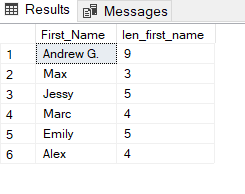
Spaces at the end of the string are not taken into account when calculating the length. However, spaces at the beginning or between the string are taken into account when calculating the length (see customer 1).
SELECT First_Name,
DATALENGTH(First_Name) AS length_first_name
FROM customers
;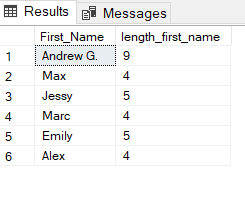
Compared to LEN, the DATALENGTH() function counts both leading and trailing spaces when calculating the length of the expression. See customer 2 (‘Max’). Here, a space was inserted at the end of the first name in the table when the column was inserted.
3.2 Get the length of numeric values
This also works with LEN:
SELECT Purchasing_Power,
LEN(Purchasing_Power) AS len_first_name
FROM customers
;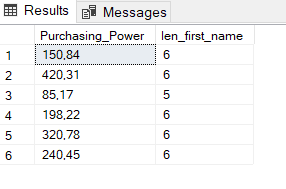
But not with DATALENGTH
SELECT Purchasing_Power,
DATALENGTH(Purchasing_Power) AS length_first_name
FROM customers
;
3.3 Get character index
SELECT Country, CHARINDEX('a', Country) AS MatchPosition
FROM customers
; 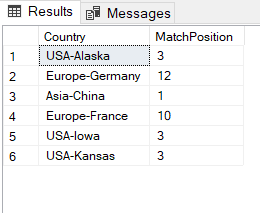
The CHARINDEX() function searches for a substring in a string and returns the position. If this substing should not be found because it is not contained, the function returns the value 0.
SELECT Country, CHARINDEX('as', Country) AS MatchPosition
FROM customers
; 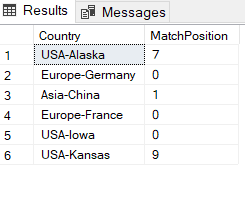
3.4 Comparison of two strings
DIFFERENCE compares two strings with each other and returns their similarity in a range of 0-4.
SELECT DIFFERENCE('Michael', 'Mike'); 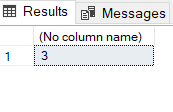
We see here that the names ‘Michael’ and ‘Mike’ with a value of 3 are similar.
SELECT DIFFERENCE('Michael', 'Andreas'); 
Whereas ‘Michael’ and ‘Andreas’ have less in common.
Let’s compare the first and last names of the people in our table:
SELECT First_Name, Last_Name,
DIFFERENCE(First_Name, Last_Name) AS diff
FROM customers
;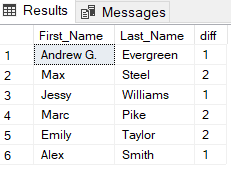
3.5 Receiving parts from a string
3.5.1 LEFT
Here we get the first character of the string from Last_Name.
SELECT Last_Name,
LEFT(Last_Name, 1) AS first_char
FROM customers
;
3.5.2 RIGHT
Here we get the last 3 characters of the string from Last_Name.
SELECT Last_Name,
RIGHT(Last_Name, 3) AS last_3_chars
FROM customers
;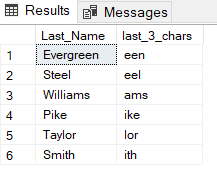
3.5.3 SUBSTRING
So far we have only output the first or last characters of a string. We can determine the position and length of the desired substring even more precisely with the SUBSTRING function.
Example: SUBSTRING(string, start, length)
SELECT Webpage,
SUBSTRING(Webpage, 4, 3) AS extracted_substring
FROM customers
;
3.6 Connecting character strings
3.6.1 With CONCAT
In my post Data Wrangling I showed how to (quick and dirty) join two string columns. The correct function for this would be CONCAT.
SELECT First_Name, Last_Name,
CONCAT(First_Name, Last_Name) AS Full_Name
FROM customers
;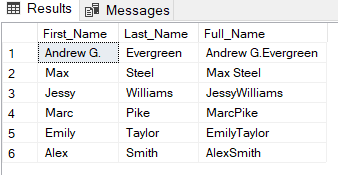
Or a little more beautiful:
SELECT First_Name, Last_Name,
CONCAT(First_Name, ' ', Last_Name) AS Full_Name
FROM customers
;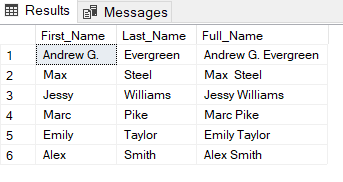
3.7 Separating character strings
The separation of strings is a bit more difficult and for this we need the knowledge gained in the previous chapters.
For this, let’s look at the Country column. In addition to the country, it also contains the corresponding continent and is therefore not a real country column.
SELECT Country
FROM customers
;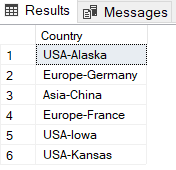
But we can create a proper country column:
SELECT Country,
SUBSTRING(Country, 1, CHARINDEX('-', Country)-1) AS Continent,
SUBSTRING(Country, CHARINDEX('-', Country)+1, LEN(Country)) AS real_Country
FROM customers
;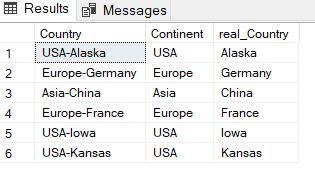
How exactly does this Select Statement work?
On the one hand I use the SUBSTRING function to extract parts of the complete string. As described above, with this function I can determine from which and up to which position of the whole string I want to extract the substring.
For the first substring I want to extract the continent. Therefore I tell the SUBSTRING function to start at position 1 to extract the substring up to the position of the hyphen (-) character (minus 1, so I don’t take over the hyphen).
For the second substring I start at the position of the hyphen (plus 1, so I don’t take over the hyphen again) and output all remaining characters of the string with the LEN function.
3.8 Manipulating Strings
3.8.3 Remove leading spaces from a string
3.8.3.1 RTRIM
RTRIM removes all spaces to the right of a string.
We saw above that the DATALENGTH function counted 4 characters for Max because Max was inserted into the table with a space at the end of the name.
SELECT First_Name,
DATALENGTH(First_Name) AS length_first_name
FROM customers
WHERE First_Name = 'Max'
;
If you have a problem with spaces, it may be advisable to remove them. This works in our case with RTRIM, because the space was inserted at the end of the first name.
SELECT First_Name,
DATALENGTH(RTRIM(First_Name)) AS length_trimmed_first_name
FROM customers
WHERE First_Name = 'Max'
;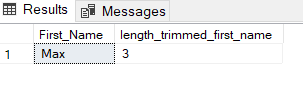
3.8.3.2 LTRIM
LTRIM removes all spaces to the left of a string.
We do not have an example for this in our table, but it is also possible to demonstrate it:
SELECT ' SQL Server Functions' AS normal_string,
LTRIM(' SQL Server Functions') AS trimmed_string
; 
3.8.3.3 TRIM
Now we have seen how to remove left and right spaces from a string. But what if we have a space on both sides?
SELECT ' SQL Server Functions ' AS normal_string,
DATALENGTH(' SQL Server Functions ') AS length_normal_str
;
Do I really need to use both functions (LTRIM and RTRIM) at the same time here?
SELECT ' SQL Server Functions ' AS normal_string,
DATALENGTH(' SQL Server Functions ') AS length_normal_str,
DATALENGTH(LTRIM(RTRIM(' SQL Server Functions '))) AS trimmed_str
;
Of course not! There is also a function in SQL for this: TRIM
Here is a comparison of all TRIM types we have seen so far, including the TRIM function:
SELECT ' SQL Server Functions ' AS normal_string,
DATALENGTH(' SQL Server Functions ') AS length_normal_str,
DATALENGTH(LTRIM(' SQL Server Functions ')) AS left_trimmed_str,
DATALENGTH(RTRIM(' SQL Server Functions ')) AS right_trimmed_str,
DATALENGTH(TRIM(' SQL Server Functions ')) AS trimmed_str
; 
3.8.4 Replace string characters
3.8.4.1 Replace leading spaces from a string
However, we have not yet solved one problem. What do we do with unwanted spaces between two strings from one column? We cannot accomplish this with LTRIM, RTRIM or TRIM.
We had shown an example at the beginning that contains exactly this problem. See here customer number 1 with the function DATALENGTH:
SELECT First_Name,
DATALENGTH(First_Name) AS length_first_name
FROM customers
WHERE First_Name = 'Andrew G.'
;
To remove spaces between two strings we need REPLACE.
SELECT First_Name,
DATALENGTH(First_Name) AS length_first_name,
DATALENGTH(REPLACE(First_Name, ' ', '')) AS length_replaced_first_name
FROM customers
WHERE First_Name = 'Andrew G.'
;
REPLACE also works wonderfully with spaces before or at the end of strings. See our updated example from the previous chapter:
SELECT ' SQL Server Functions ' AS normal_string,
DATALENGTH(' SQL Server Functions ') AS length_normal_str,
DATALENGTH(LTRIM(' SQL Server Functions ')) AS left_trimmed_str,
DATALENGTH(RTRIM(' SQL Server Functions ')) AS right_trimmed_str,
DATALENGTH(TRIM(' SQL Server Functions ')) AS trimmed_str,
DATALENGTH(REPLACE(' SQL Server Functions ', ' ', '')) AS length_replaced_str
; 
3.8.4.2 Replace specific character letters
Of course, REPLACE can also be used to replace certain letters with others.
SELECT Country,
REPLACE(Country, 'USA', ' United States of America') AS full_country
FROM customers
;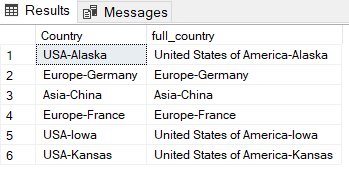
3.8.4.3 Replace character letters at a specific position
REPLACE is a powerful function but it also has its limits, see the following example.
SELECT Webpage
FROM customers
;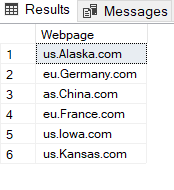
Someone has used here the abbreviations of the continents, which do not work as address of a homepage so. They should start with www.
Let’s try it with a nested REPLACE statement.
SELECT Webpage,
REPLACE(REPLACE(REPLACE(Webpage, 'us', 'www'), 'eu', 'www'), 'as', 'www') AS repl_Webpage
FROM customers
;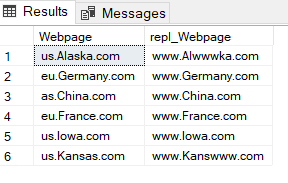
Doesn’t work (see Alaska and Kansas) even if you were to change the order a little bit here. And even if it did, the syntax wouldn’t be very nice to read.
If we have the problem to replace certain parts of a string that are always the same in position, we can resort to the STUFF function. It deletes a part of a string and then inserts another part into the string, starting at a certain position.
SELECT Webpage,
STUFF(Webpage, 1, 2, 'www') AS repl_Webpage
FROM customers
; 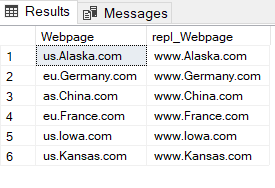
Looks already much better and is much easier to write / read.
